Talent Management's Role in Cultural Change: A Study of Morrison
VerifiedAdded on 2023/06/14
|28
|5945
|236
Project
AI Summary
This research project investigates the role of talent management as a lever for cultural change within an organization, specifically focusing on Morrison. It explores talent management practices used by Morrison, the significance of these strategies for cultural change, and the challenges faced during their development. The research employs a deductive approach, utilizing statistical methods for data analysis. Findings from the study highlight the importance of aligning organizational and individual goals, conducting regular employee reviews, and providing consistent feedback. Effective talent management is crucial for attracting and retaining talented employees, enhancing performance, increasing employee engagement, and ultimately improving customer satisfaction. The study concludes by offering recommendations for Morrison and suggesting areas for future research, emphasizing the need for companies to focus on implementing good talent management plans for training and motivating employees to achieve positive growth and development.
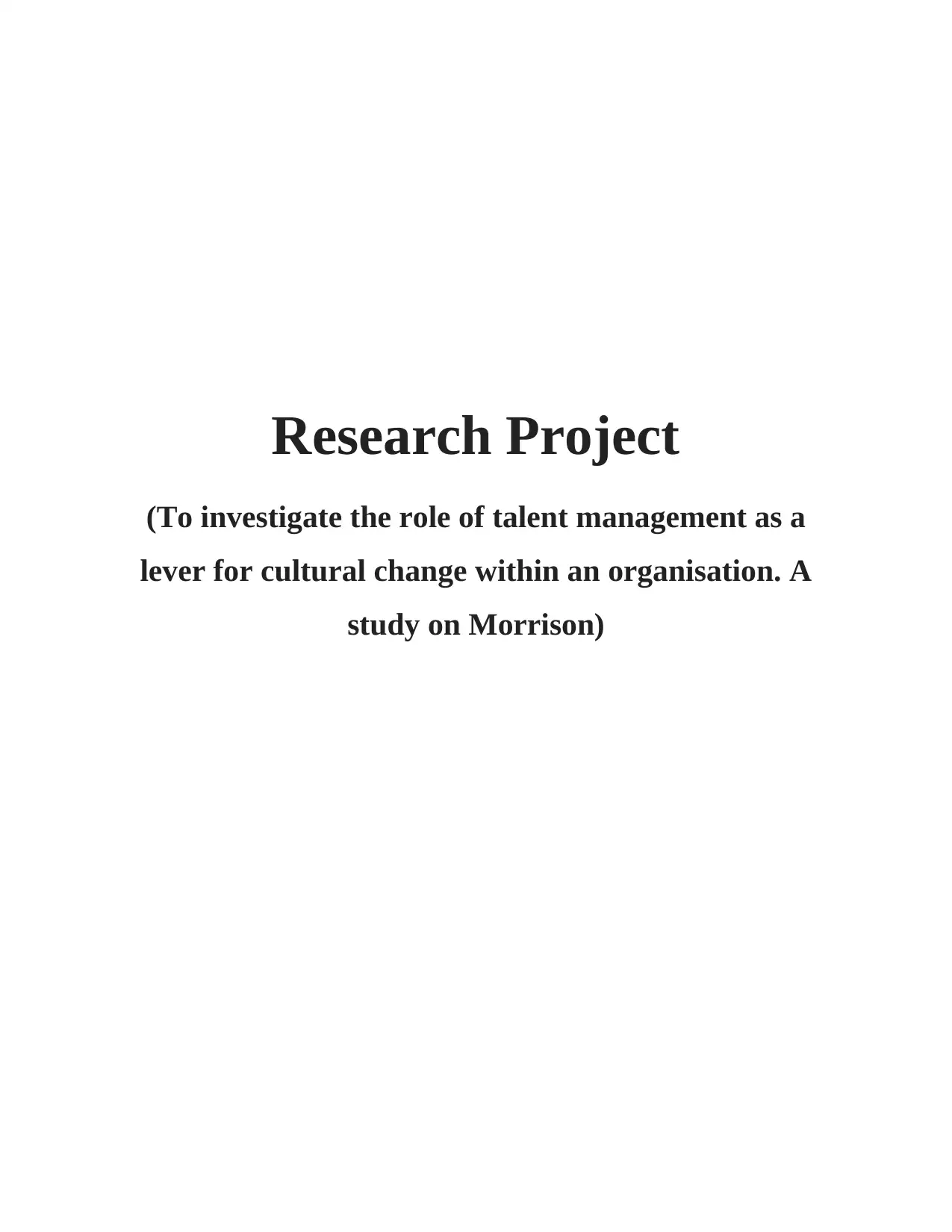
Research Project
(To investigate the role of talent management as a
lever for cultural change within an organisation. A
study on Morrison)
(To investigate the role of talent management as a
lever for cultural change within an organisation. A
study on Morrison)
Paraphrase This Document
Need a fresh take? Get an instant paraphrase of this document with our AI Paraphraser
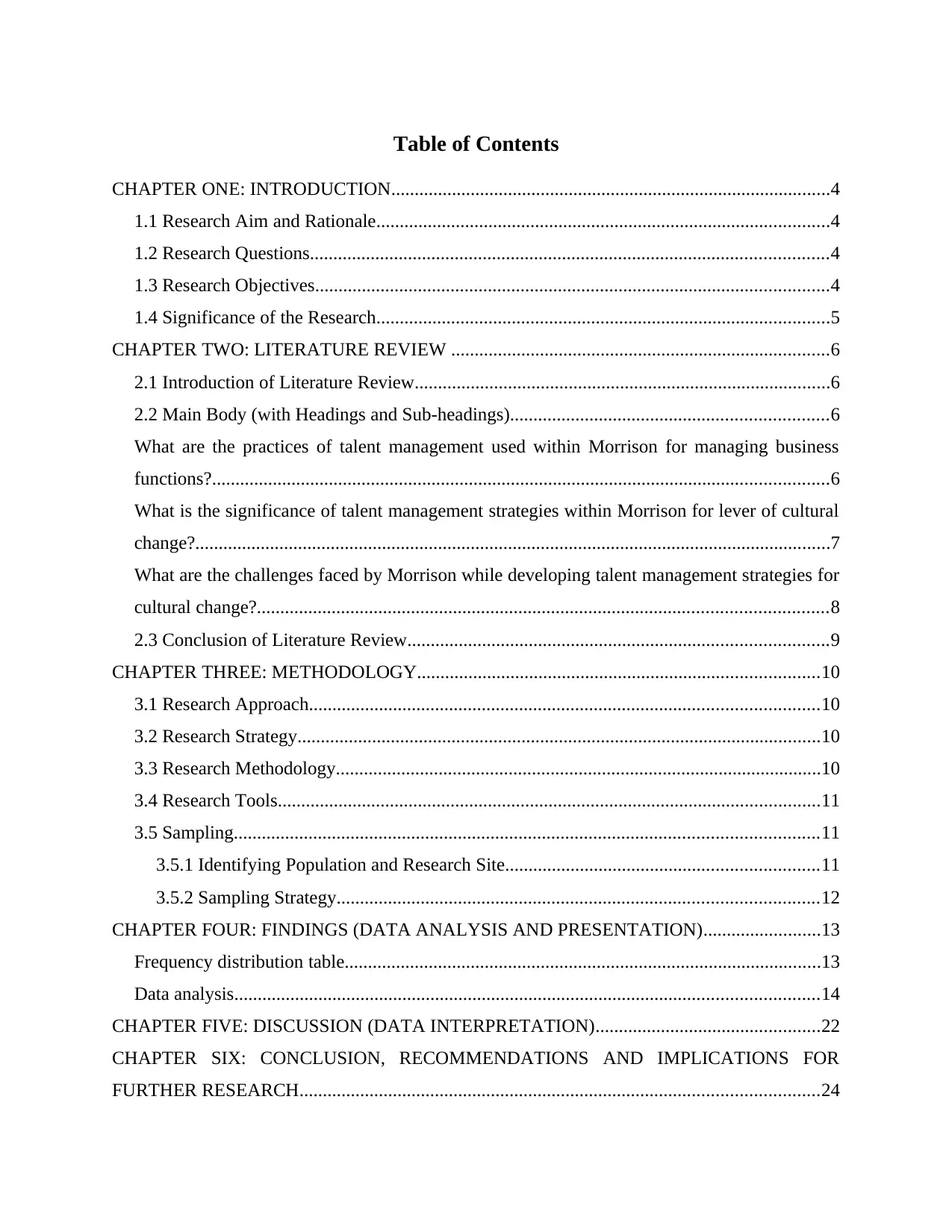
Table of Contents
CHAPTER ONE: INTRODUCTION..............................................................................................4
1.1 Research Aim and Rationale.................................................................................................4
1.2 Research Questions...............................................................................................................4
1.3 Research Objectives..............................................................................................................4
1.4 Significance of the Research.................................................................................................5
CHAPTER TWO: LITERATURE REVIEW .................................................................................6
2.1 Introduction of Literature Review.........................................................................................6
2.2 Main Body (with Headings and Sub-headings)....................................................................6
What are the practices of talent management used within Morrison for managing business
functions?....................................................................................................................................6
What is the significance of talent management strategies within Morrison for lever of cultural
change?........................................................................................................................................7
What are the challenges faced by Morrison while developing talent management strategies for
cultural change?..........................................................................................................................8
2.3 Conclusion of Literature Review..........................................................................................9
CHAPTER THREE: METHODOLOGY......................................................................................10
3.1 Research Approach.............................................................................................................10
3.2 Research Strategy................................................................................................................10
3.3 Research Methodology........................................................................................................10
3.4 Research Tools....................................................................................................................11
3.5 Sampling.............................................................................................................................11
3.5.1 Identifying Population and Research Site...................................................................11
3.5.2 Sampling Strategy.......................................................................................................12
CHAPTER FOUR: FINDINGS (DATA ANALYSIS AND PRESENTATION).........................13
Frequency distribution table......................................................................................................13
Data analysis.............................................................................................................................14
CHAPTER FIVE: DISCUSSION (DATA INTERPRETATION)................................................22
CHAPTER SIX: CONCLUSION, RECOMMENDATIONS AND IMPLICATIONS FOR
FURTHER RESEARCH...............................................................................................................24
CHAPTER ONE: INTRODUCTION..............................................................................................4
1.1 Research Aim and Rationale.................................................................................................4
1.2 Research Questions...............................................................................................................4
1.3 Research Objectives..............................................................................................................4
1.4 Significance of the Research.................................................................................................5
CHAPTER TWO: LITERATURE REVIEW .................................................................................6
2.1 Introduction of Literature Review.........................................................................................6
2.2 Main Body (with Headings and Sub-headings)....................................................................6
What are the practices of talent management used within Morrison for managing business
functions?....................................................................................................................................6
What is the significance of talent management strategies within Morrison for lever of cultural
change?........................................................................................................................................7
What are the challenges faced by Morrison while developing talent management strategies for
cultural change?..........................................................................................................................8
2.3 Conclusion of Literature Review..........................................................................................9
CHAPTER THREE: METHODOLOGY......................................................................................10
3.1 Research Approach.............................................................................................................10
3.2 Research Strategy................................................................................................................10
3.3 Research Methodology........................................................................................................10
3.4 Research Tools....................................................................................................................11
3.5 Sampling.............................................................................................................................11
3.5.1 Identifying Population and Research Site...................................................................11
3.5.2 Sampling Strategy.......................................................................................................12
CHAPTER FOUR: FINDINGS (DATA ANALYSIS AND PRESENTATION).........................13
Frequency distribution table......................................................................................................13
Data analysis.............................................................................................................................14
CHAPTER FIVE: DISCUSSION (DATA INTERPRETATION)................................................22
CHAPTER SIX: CONCLUSION, RECOMMENDATIONS AND IMPLICATIONS FOR
FURTHER RESEARCH...............................................................................................................24
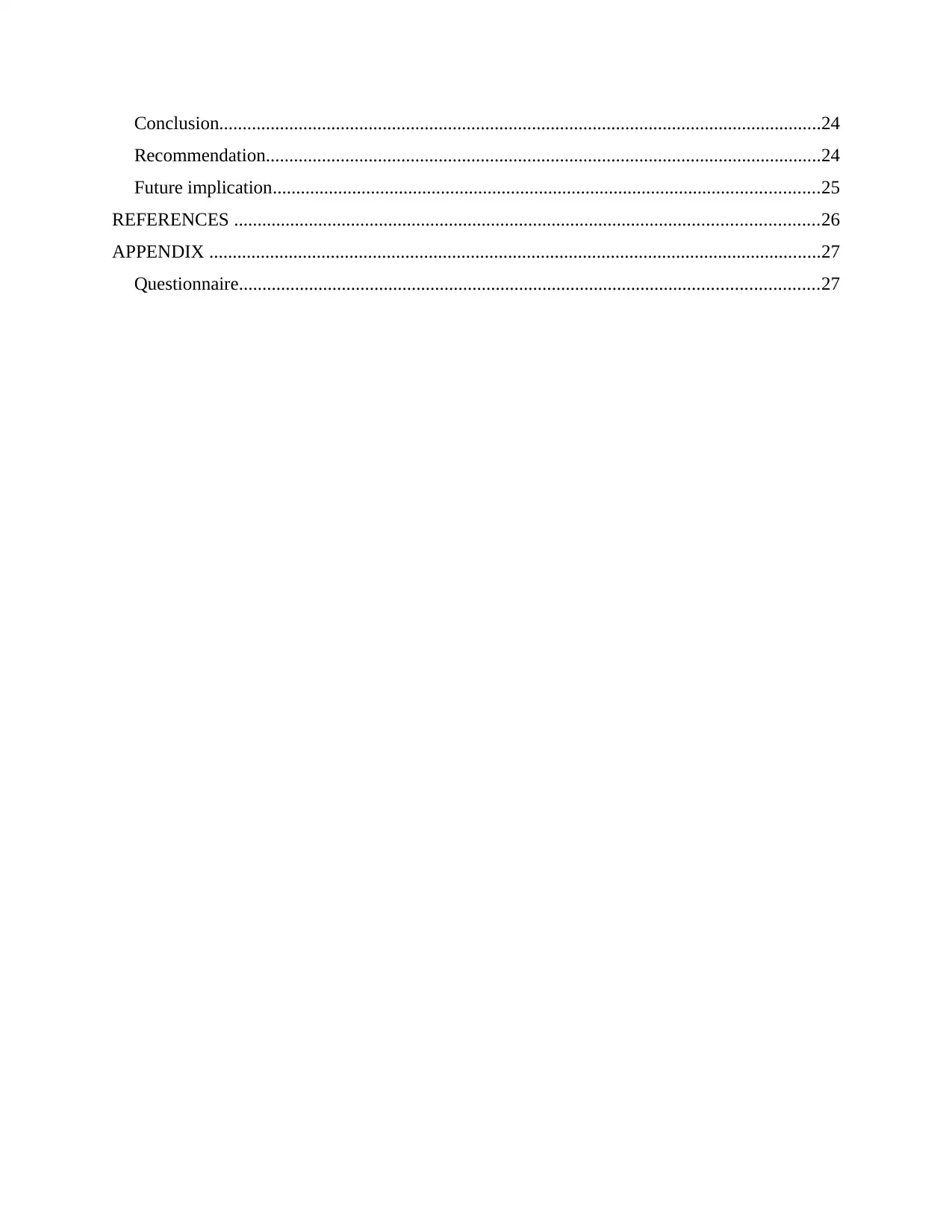
Conclusion.................................................................................................................................24
Recommendation.......................................................................................................................24
Future implication.....................................................................................................................25
REFERENCES .............................................................................................................................26
APPENDIX ...................................................................................................................................27
Questionnaire............................................................................................................................27
Recommendation.......................................................................................................................24
Future implication.....................................................................................................................25
REFERENCES .............................................................................................................................26
APPENDIX ...................................................................................................................................27
Questionnaire............................................................................................................................27
⊘ This is a preview!⊘
Do you want full access?
Subscribe today to unlock all pages.

Trusted by 1+ million students worldwide
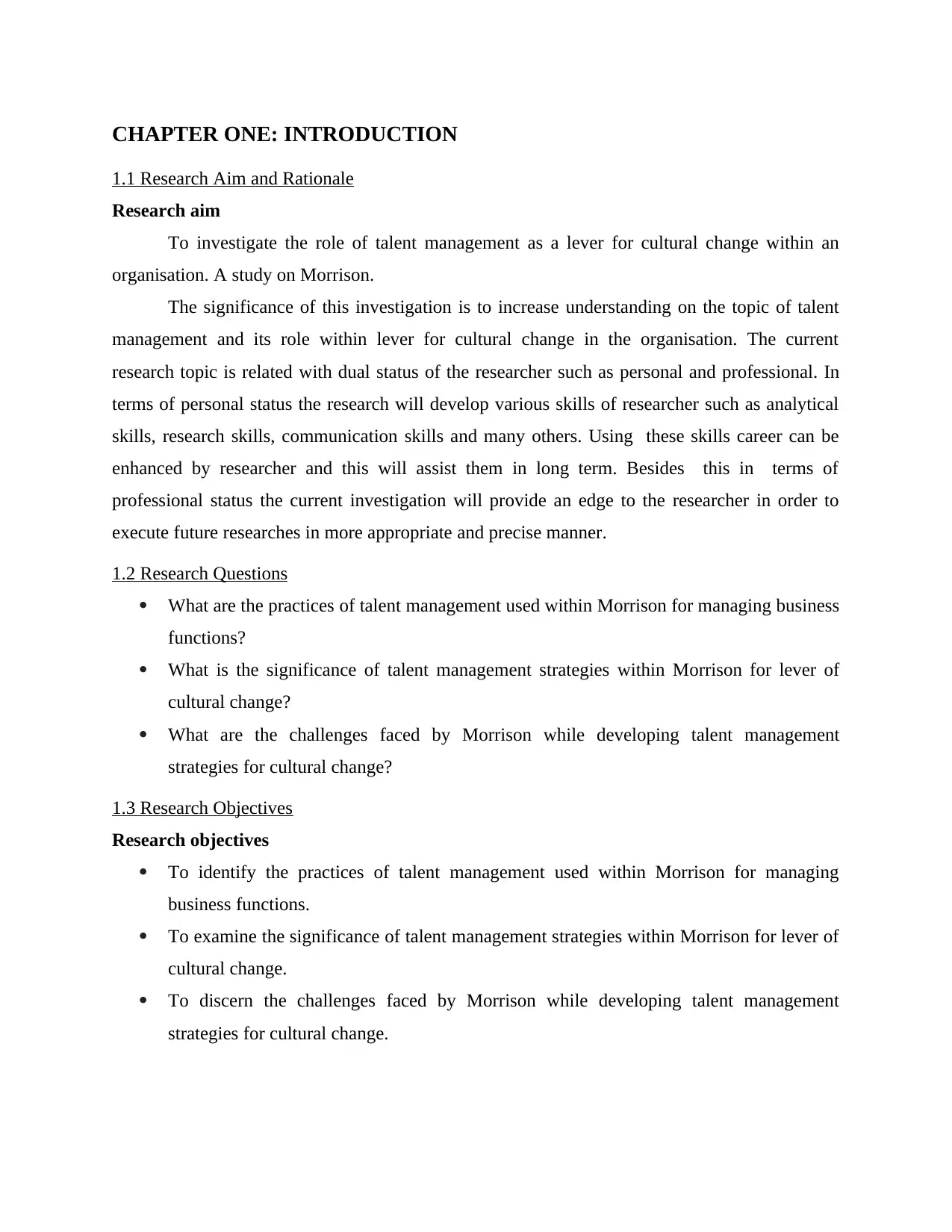
CHAPTER ONE: INTRODUCTION
1.1 Research Aim and Rationale
Research aim
To investigate the role of talent management as a lever for cultural change within an
organisation. A study on Morrison.
The significance of this investigation is to increase understanding on the topic of talent
management and its role within lever for cultural change in the organisation. The current
research topic is related with dual status of the researcher such as personal and professional. In
terms of personal status the research will develop various skills of researcher such as analytical
skills, research skills, communication skills and many others. Using these skills career can be
enhanced by researcher and this will assist them in long term. Besides this in terms of
professional status the current investigation will provide an edge to the researcher in order to
execute future researches in more appropriate and precise manner.
1.2 Research Questions
What are the practices of talent management used within Morrison for managing business
functions?
What is the significance of talent management strategies within Morrison for lever of
cultural change?
What are the challenges faced by Morrison while developing talent management
strategies for cultural change?
1.3 Research Objectives
Research objectives
To identify the practices of talent management used within Morrison for managing
business functions.
To examine the significance of talent management strategies within Morrison for lever of
cultural change.
To discern the challenges faced by Morrison while developing talent management
strategies for cultural change.
1.1 Research Aim and Rationale
Research aim
To investigate the role of talent management as a lever for cultural change within an
organisation. A study on Morrison.
The significance of this investigation is to increase understanding on the topic of talent
management and its role within lever for cultural change in the organisation. The current
research topic is related with dual status of the researcher such as personal and professional. In
terms of personal status the research will develop various skills of researcher such as analytical
skills, research skills, communication skills and many others. Using these skills career can be
enhanced by researcher and this will assist them in long term. Besides this in terms of
professional status the current investigation will provide an edge to the researcher in order to
execute future researches in more appropriate and precise manner.
1.2 Research Questions
What are the practices of talent management used within Morrison for managing business
functions?
What is the significance of talent management strategies within Morrison for lever of
cultural change?
What are the challenges faced by Morrison while developing talent management
strategies for cultural change?
1.3 Research Objectives
Research objectives
To identify the practices of talent management used within Morrison for managing
business functions.
To examine the significance of talent management strategies within Morrison for lever of
cultural change.
To discern the challenges faced by Morrison while developing talent management
strategies for cultural change.
Paraphrase This Document
Need a fresh take? Get an instant paraphrase of this document with our AI Paraphraser
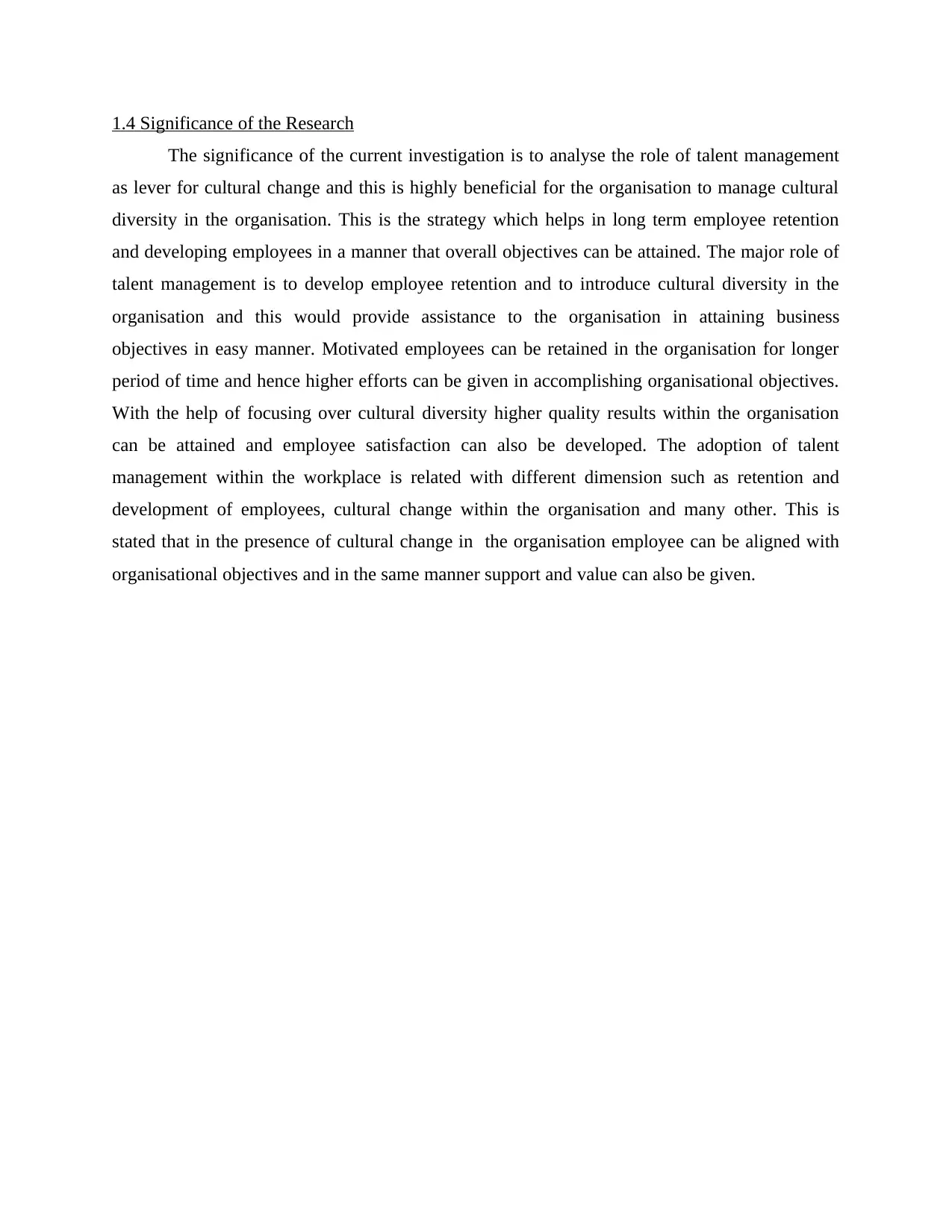
1.4 Significance of the Research
The significance of the current investigation is to analyse the role of talent management
as lever for cultural change and this is highly beneficial for the organisation to manage cultural
diversity in the organisation. This is the strategy which helps in long term employee retention
and developing employees in a manner that overall objectives can be attained. The major role of
talent management is to develop employee retention and to introduce cultural diversity in the
organisation and this would provide assistance to the organisation in attaining business
objectives in easy manner. Motivated employees can be retained in the organisation for longer
period of time and hence higher efforts can be given in accomplishing organisational objectives.
With the help of focusing over cultural diversity higher quality results within the organisation
can be attained and employee satisfaction can also be developed. The adoption of talent
management within the workplace is related with different dimension such as retention and
development of employees, cultural change within the organisation and many other. This is
stated that in the presence of cultural change in the organisation employee can be aligned with
organisational objectives and in the same manner support and value can also be given.
The significance of the current investigation is to analyse the role of talent management
as lever for cultural change and this is highly beneficial for the organisation to manage cultural
diversity in the organisation. This is the strategy which helps in long term employee retention
and developing employees in a manner that overall objectives can be attained. The major role of
talent management is to develop employee retention and to introduce cultural diversity in the
organisation and this would provide assistance to the organisation in attaining business
objectives in easy manner. Motivated employees can be retained in the organisation for longer
period of time and hence higher efforts can be given in accomplishing organisational objectives.
With the help of focusing over cultural diversity higher quality results within the organisation
can be attained and employee satisfaction can also be developed. The adoption of talent
management within the workplace is related with different dimension such as retention and
development of employees, cultural change within the organisation and many other. This is
stated that in the presence of cultural change in the organisation employee can be aligned with
organisational objectives and in the same manner support and value can also be given.
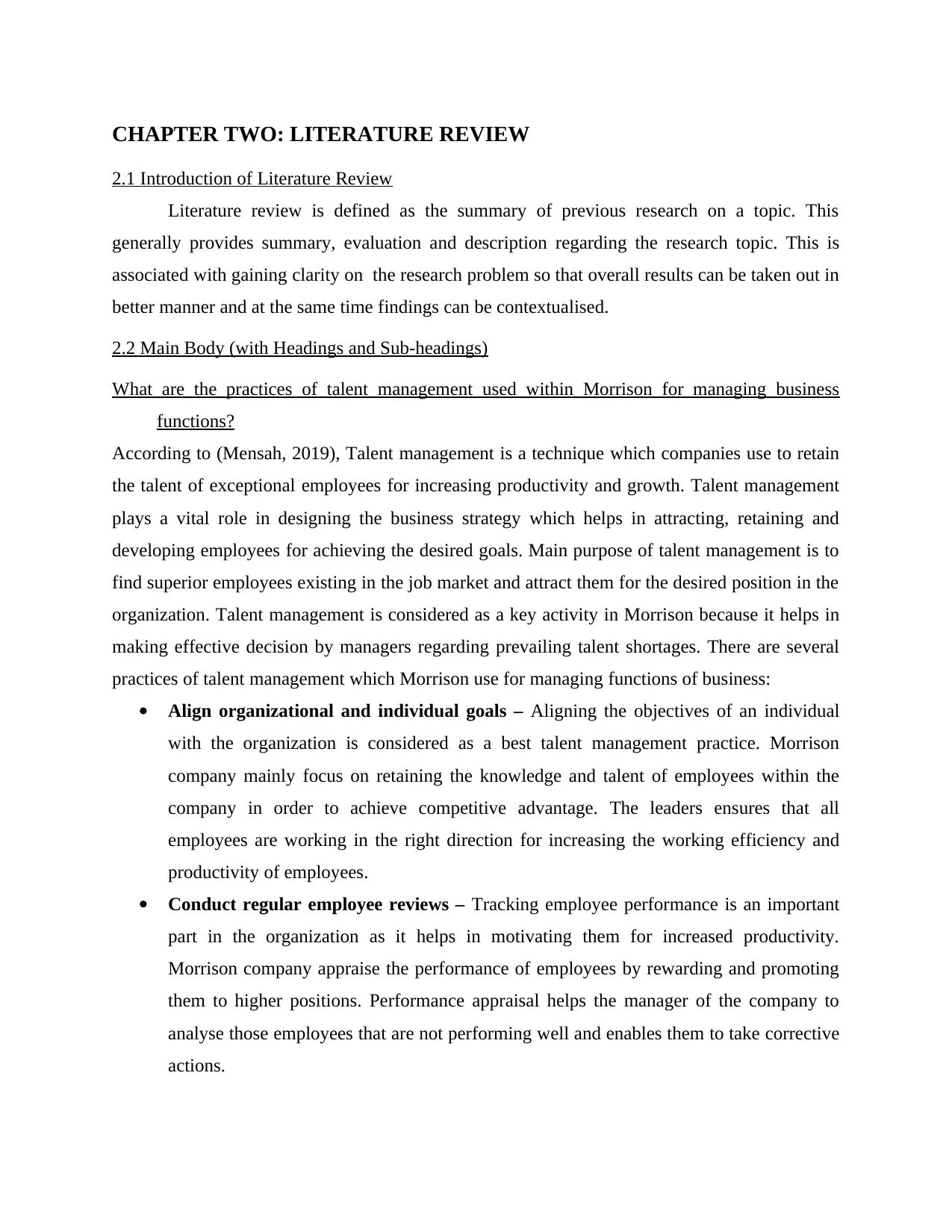
CHAPTER TWO: LITERATURE REVIEW
2.1 Introduction of Literature Review
Literature review is defined as the summary of previous research on a topic. This
generally provides summary, evaluation and description regarding the research topic. This is
associated with gaining clarity on the research problem so that overall results can be taken out in
better manner and at the same time findings can be contextualised.
2.2 Main Body (with Headings and Sub-headings)
What are the practices of talent management used within Morrison for managing business
functions?
According to (Mensah, 2019), Talent management is a technique which companies use to retain
the talent of exceptional employees for increasing productivity and growth. Talent management
plays a vital role in designing the business strategy which helps in attracting, retaining and
developing employees for achieving the desired goals. Main purpose of talent management is to
find superior employees existing in the job market and attract them for the desired position in the
organization. Talent management is considered as a key activity in Morrison because it helps in
making effective decision by managers regarding prevailing talent shortages. There are several
practices of talent management which Morrison use for managing functions of business:
Align organizational and individual goals – Aligning the objectives of an individual
with the organization is considered as a best talent management practice. Morrison
company mainly focus on retaining the knowledge and talent of employees within the
company in order to achieve competitive advantage. The leaders ensures that all
employees are working in the right direction for increasing the working efficiency and
productivity of employees.
Conduct regular employee reviews – Tracking employee performance is an important
part in the organization as it helps in motivating them for increased productivity.
Morrison company appraise the performance of employees by rewarding and promoting
them to higher positions. Performance appraisal helps the manager of the company to
analyse those employees that are not performing well and enables them to take corrective
actions.
2.1 Introduction of Literature Review
Literature review is defined as the summary of previous research on a topic. This
generally provides summary, evaluation and description regarding the research topic. This is
associated with gaining clarity on the research problem so that overall results can be taken out in
better manner and at the same time findings can be contextualised.
2.2 Main Body (with Headings and Sub-headings)
What are the practices of talent management used within Morrison for managing business
functions?
According to (Mensah, 2019), Talent management is a technique which companies use to retain
the talent of exceptional employees for increasing productivity and growth. Talent management
plays a vital role in designing the business strategy which helps in attracting, retaining and
developing employees for achieving the desired goals. Main purpose of talent management is to
find superior employees existing in the job market and attract them for the desired position in the
organization. Talent management is considered as a key activity in Morrison because it helps in
making effective decision by managers regarding prevailing talent shortages. There are several
practices of talent management which Morrison use for managing functions of business:
Align organizational and individual goals – Aligning the objectives of an individual
with the organization is considered as a best talent management practice. Morrison
company mainly focus on retaining the knowledge and talent of employees within the
company in order to achieve competitive advantage. The leaders ensures that all
employees are working in the right direction for increasing the working efficiency and
productivity of employees.
Conduct regular employee reviews – Tracking employee performance is an important
part in the organization as it helps in motivating them for increased productivity.
Morrison company appraise the performance of employees by rewarding and promoting
them to higher positions. Performance appraisal helps the manager of the company to
analyse those employees that are not performing well and enables them to take corrective
actions.
⊘ This is a preview!⊘
Do you want full access?
Subscribe today to unlock all pages.

Trusted by 1+ million students worldwide
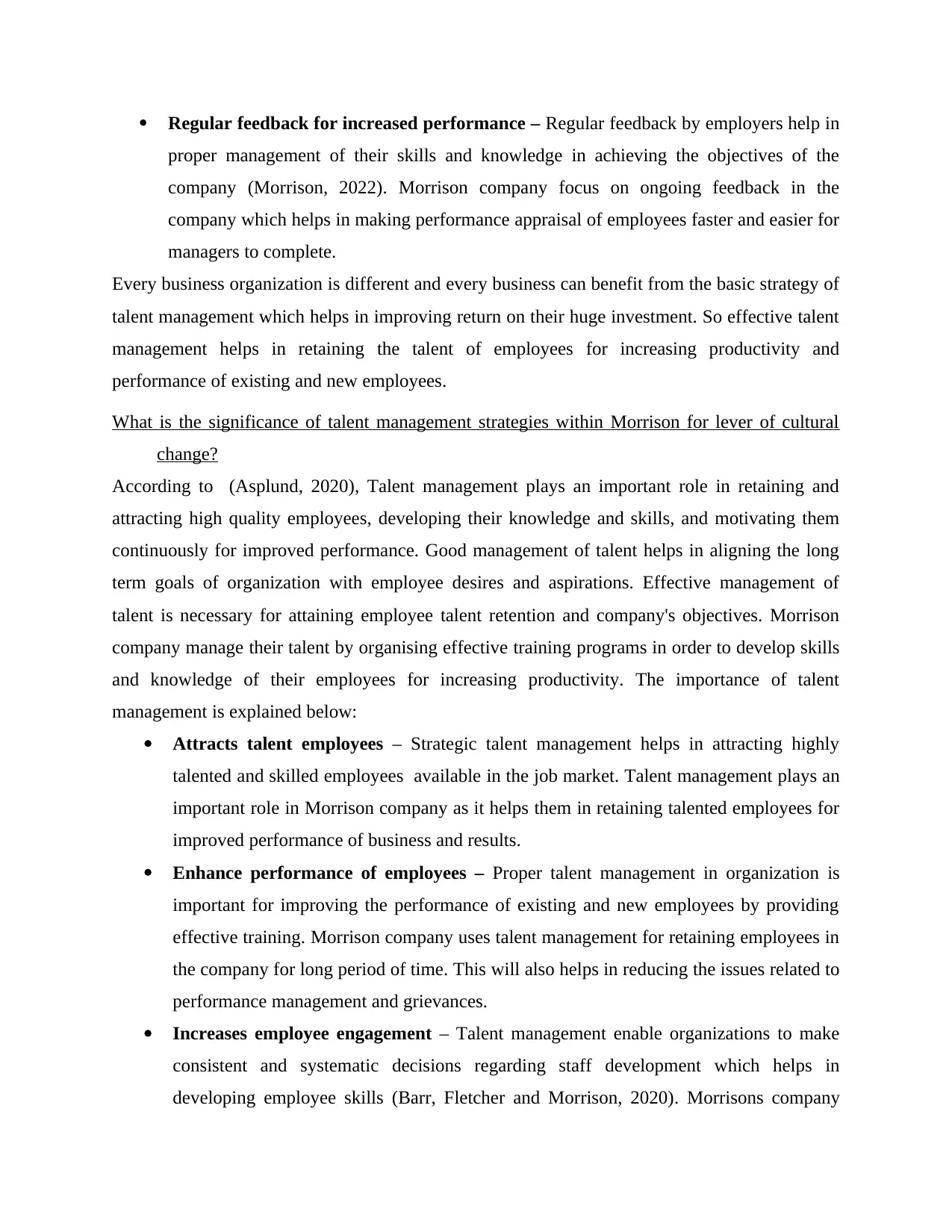
Regular feedback for increased performance – Regular feedback by employers help in
proper management of their skills and knowledge in achieving the objectives of the
company (Morrison, 2022). Morrison company focus on ongoing feedback in the
company which helps in making performance appraisal of employees faster and easier for
managers to complete.
Every business organization is different and every business can benefit from the basic strategy of
talent management which helps in improving return on their huge investment. So effective talent
management helps in retaining the talent of employees for increasing productivity and
performance of existing and new employees.
What is the significance of talent management strategies within Morrison for lever of cultural
change?
According to (Asplund, 2020), Talent management plays an important role in retaining and
attracting high quality employees, developing their knowledge and skills, and motivating them
continuously for improved performance. Good management of talent helps in aligning the long
term goals of organization with employee desires and aspirations. Effective management of
talent is necessary for attaining employee talent retention and company's objectives. Morrison
company manage their talent by organising effective training programs in order to develop skills
and knowledge of their employees for increasing productivity. The importance of talent
management is explained below:
Attracts talent employees – Strategic talent management helps in attracting highly
talented and skilled employees available in the job market. Talent management plays an
important role in Morrison company as it helps them in retaining talented employees for
improved performance of business and results.
Enhance performance of employees – Proper talent management in organization is
important for improving the performance of existing and new employees by providing
effective training. Morrison company uses talent management for retaining employees in
the company for long period of time. This will also helps in reducing the issues related to
performance management and grievances.
Increases employee engagement – Talent management enable organizations to make
consistent and systematic decisions regarding staff development which helps in
developing employee skills (Barr, Fletcher and Morrison, 2020). Morrisons company
proper management of their skills and knowledge in achieving the objectives of the
company (Morrison, 2022). Morrison company focus on ongoing feedback in the
company which helps in making performance appraisal of employees faster and easier for
managers to complete.
Every business organization is different and every business can benefit from the basic strategy of
talent management which helps in improving return on their huge investment. So effective talent
management helps in retaining the talent of employees for increasing productivity and
performance of existing and new employees.
What is the significance of talent management strategies within Morrison for lever of cultural
change?
According to (Asplund, 2020), Talent management plays an important role in retaining and
attracting high quality employees, developing their knowledge and skills, and motivating them
continuously for improved performance. Good management of talent helps in aligning the long
term goals of organization with employee desires and aspirations. Effective management of
talent is necessary for attaining employee talent retention and company's objectives. Morrison
company manage their talent by organising effective training programs in order to develop skills
and knowledge of their employees for increasing productivity. The importance of talent
management is explained below:
Attracts talent employees – Strategic talent management helps in attracting highly
talented and skilled employees available in the job market. Talent management plays an
important role in Morrison company as it helps them in retaining talented employees for
improved performance of business and results.
Enhance performance of employees – Proper talent management in organization is
important for improving the performance of existing and new employees by providing
effective training. Morrison company uses talent management for retaining employees in
the company for long period of time. This will also helps in reducing the issues related to
performance management and grievances.
Increases employee engagement – Talent management enable organizations to make
consistent and systematic decisions regarding staff development which helps in
developing employee skills (Barr, Fletcher and Morrison, 2020). Morrisons company
Paraphrase This Document
Need a fresh take? Get an instant paraphrase of this document with our AI Paraphraser
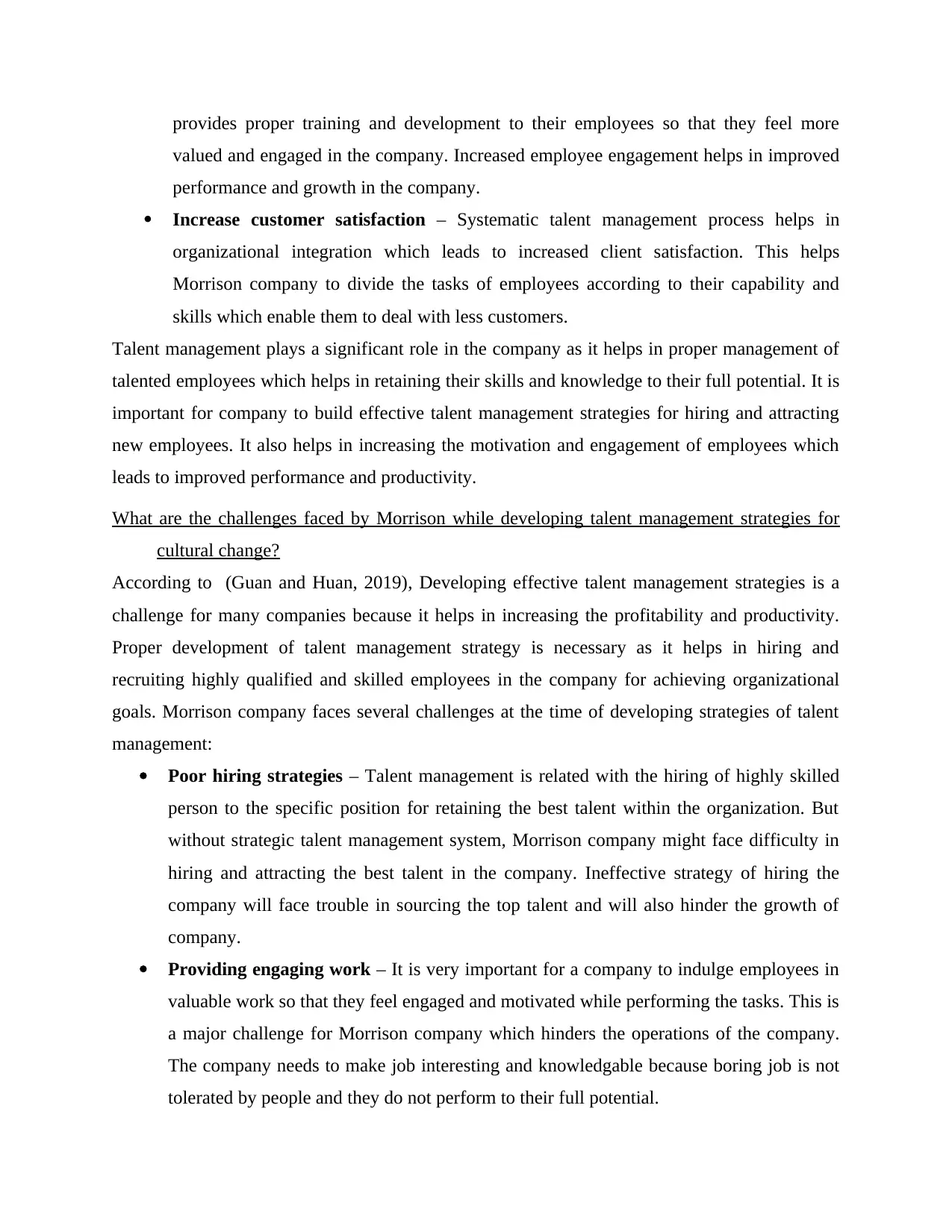
provides proper training and development to their employees so that they feel more
valued and engaged in the company. Increased employee engagement helps in improved
performance and growth in the company.
Increase customer satisfaction – Systematic talent management process helps in
organizational integration which leads to increased client satisfaction. This helps
Morrison company to divide the tasks of employees according to their capability and
skills which enable them to deal with less customers.
Talent management plays a significant role in the company as it helps in proper management of
talented employees which helps in retaining their skills and knowledge to their full potential. It is
important for company to build effective talent management strategies for hiring and attracting
new employees. It also helps in increasing the motivation and engagement of employees which
leads to improved performance and productivity.
What are the challenges faced by Morrison while developing talent management strategies for
cultural change?
According to (Guan and Huan, 2019), Developing effective talent management strategies is a
challenge for many companies because it helps in increasing the profitability and productivity.
Proper development of talent management strategy is necessary as it helps in hiring and
recruiting highly qualified and skilled employees in the company for achieving organizational
goals. Morrison company faces several challenges at the time of developing strategies of talent
management:
Poor hiring strategies – Talent management is related with the hiring of highly skilled
person to the specific position for retaining the best talent within the organization. But
without strategic talent management system, Morrison company might face difficulty in
hiring and attracting the best talent in the company. Ineffective strategy of hiring the
company will face trouble in sourcing the top talent and will also hinder the growth of
company.
Providing engaging work – It is very important for a company to indulge employees in
valuable work so that they feel engaged and motivated while performing the tasks. This is
a major challenge for Morrison company which hinders the operations of the company.
The company needs to make job interesting and knowledgable because boring job is not
tolerated by people and they do not perform to their full potential.
valued and engaged in the company. Increased employee engagement helps in improved
performance and growth in the company.
Increase customer satisfaction – Systematic talent management process helps in
organizational integration which leads to increased client satisfaction. This helps
Morrison company to divide the tasks of employees according to their capability and
skills which enable them to deal with less customers.
Talent management plays a significant role in the company as it helps in proper management of
talented employees which helps in retaining their skills and knowledge to their full potential. It is
important for company to build effective talent management strategies for hiring and attracting
new employees. It also helps in increasing the motivation and engagement of employees which
leads to improved performance and productivity.
What are the challenges faced by Morrison while developing talent management strategies for
cultural change?
According to (Guan and Huan, 2019), Developing effective talent management strategies is a
challenge for many companies because it helps in increasing the profitability and productivity.
Proper development of talent management strategy is necessary as it helps in hiring and
recruiting highly qualified and skilled employees in the company for achieving organizational
goals. Morrison company faces several challenges at the time of developing strategies of talent
management:
Poor hiring strategies – Talent management is related with the hiring of highly skilled
person to the specific position for retaining the best talent within the organization. But
without strategic talent management system, Morrison company might face difficulty in
hiring and attracting the best talent in the company. Ineffective strategy of hiring the
company will face trouble in sourcing the top talent and will also hinder the growth of
company.
Providing engaging work – It is very important for a company to indulge employees in
valuable work so that they feel engaged and motivated while performing the tasks. This is
a major challenge for Morrison company which hinders the operations of the company.
The company needs to make job interesting and knowledgable because boring job is not
tolerated by people and they do not perform to their full potential.
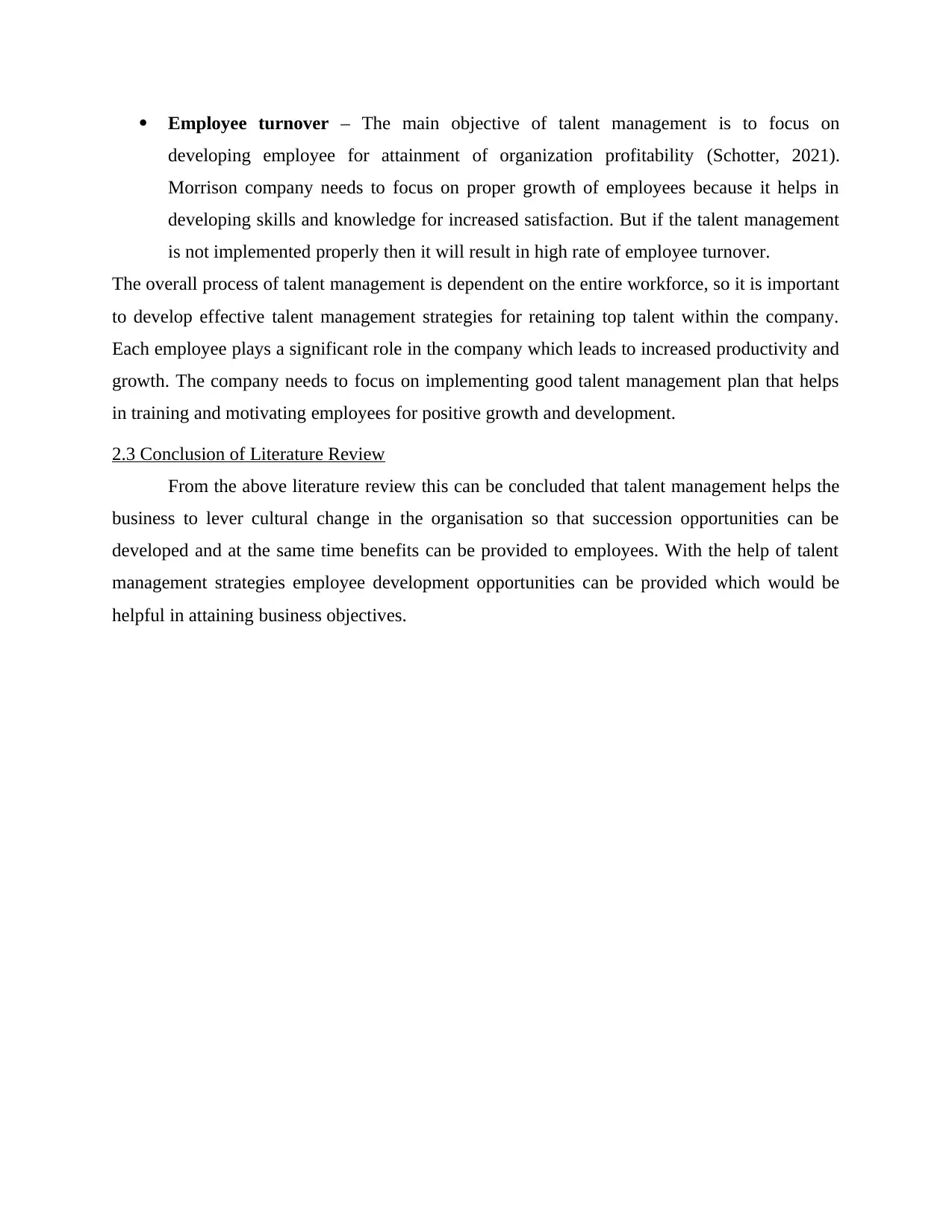
Employee turnover – The main objective of talent management is to focus on
developing employee for attainment of organization profitability (Schotter, 2021).
Morrison company needs to focus on proper growth of employees because it helps in
developing skills and knowledge for increased satisfaction. But if the talent management
is not implemented properly then it will result in high rate of employee turnover.
The overall process of talent management is dependent on the entire workforce, so it is important
to develop effective talent management strategies for retaining top talent within the company.
Each employee plays a significant role in the company which leads to increased productivity and
growth. The company needs to focus on implementing good talent management plan that helps
in training and motivating employees for positive growth and development.
2.3 Conclusion of Literature Review
From the above literature review this can be concluded that talent management helps the
business to lever cultural change in the organisation so that succession opportunities can be
developed and at the same time benefits can be provided to employees. With the help of talent
management strategies employee development opportunities can be provided which would be
helpful in attaining business objectives.
developing employee for attainment of organization profitability (Schotter, 2021).
Morrison company needs to focus on proper growth of employees because it helps in
developing skills and knowledge for increased satisfaction. But if the talent management
is not implemented properly then it will result in high rate of employee turnover.
The overall process of talent management is dependent on the entire workforce, so it is important
to develop effective talent management strategies for retaining top talent within the company.
Each employee plays a significant role in the company which leads to increased productivity and
growth. The company needs to focus on implementing good talent management plan that helps
in training and motivating employees for positive growth and development.
2.3 Conclusion of Literature Review
From the above literature review this can be concluded that talent management helps the
business to lever cultural change in the organisation so that succession opportunities can be
developed and at the same time benefits can be provided to employees. With the help of talent
management strategies employee development opportunities can be provided which would be
helpful in attaining business objectives.
⊘ This is a preview!⊘
Do you want full access?
Subscribe today to unlock all pages.

Trusted by 1+ million students worldwide
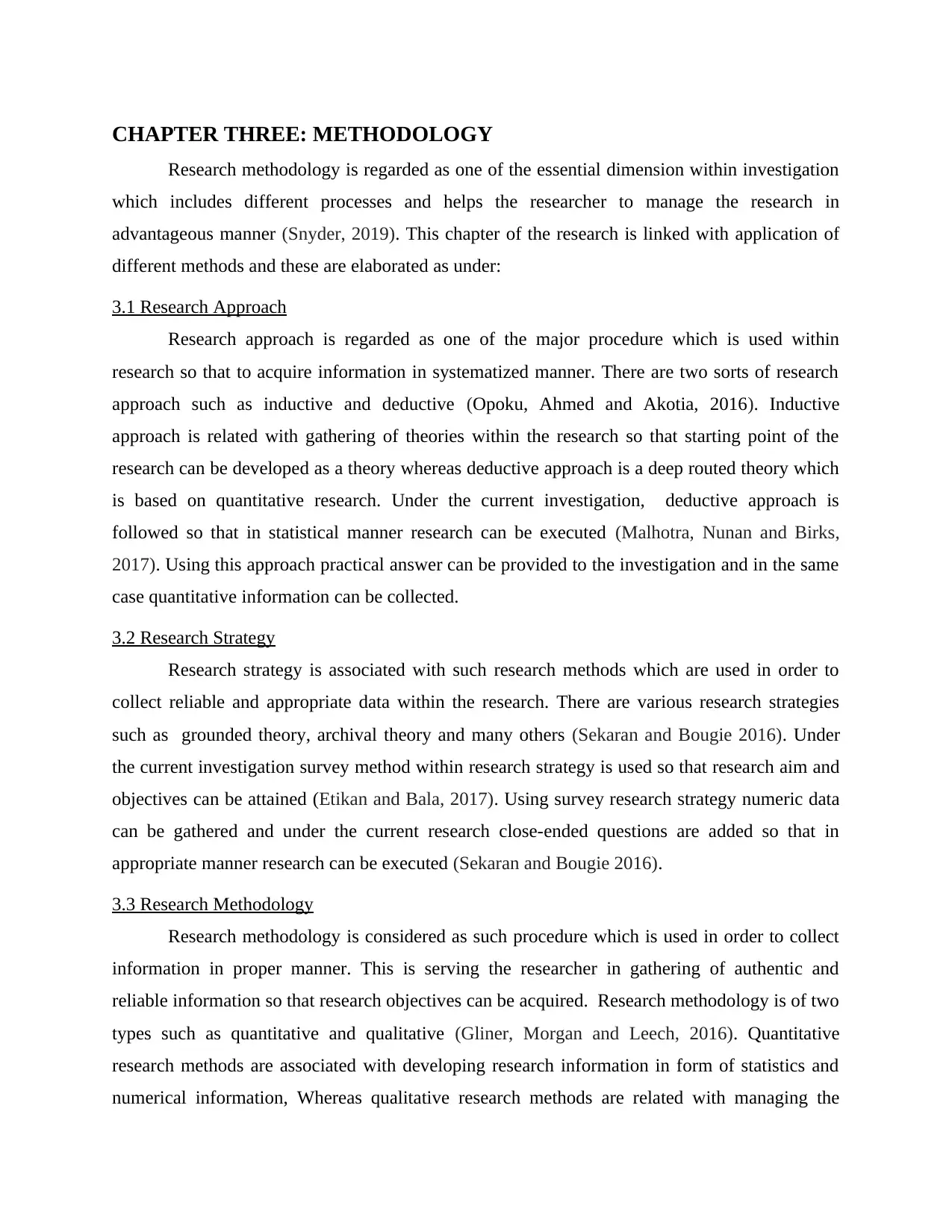
CHAPTER THREE: METHODOLOGY
Research methodology is regarded as one of the essential dimension within investigation
which includes different processes and helps the researcher to manage the research in
advantageous manner (Snyder, 2019). This chapter of the research is linked with application of
different methods and these are elaborated as under:
3.1 Research Approach
Research approach is regarded as one of the major procedure which is used within
research so that to acquire information in systematized manner. There are two sorts of research
approach such as inductive and deductive (Opoku, Ahmed and Akotia, 2016). Inductive
approach is related with gathering of theories within the research so that starting point of the
research can be developed as a theory whereas deductive approach is a deep routed theory which
is based on quantitative research. Under the current investigation, deductive approach is
followed so that in statistical manner research can be executed (Malhotra, Nunan and Birks,
2017). Using this approach practical answer can be provided to the investigation and in the same
case quantitative information can be collected.
3.2 Research Strategy
Research strategy is associated with such research methods which are used in order to
collect reliable and appropriate data within the research. There are various research strategies
such as grounded theory, archival theory and many others (Sekaran and Bougie 2016). Under
the current investigation survey method within research strategy is used so that research aim and
objectives can be attained (Etikan and Bala, 2017). Using survey research strategy numeric data
can be gathered and under the current research close-ended questions are added so that in
appropriate manner research can be executed (Sekaran and Bougie 2016).
3.3 Research Methodology
Research methodology is considered as such procedure which is used in order to collect
information in proper manner. This is serving the researcher in gathering of authentic and
reliable information so that research objectives can be acquired. Research methodology is of two
types such as quantitative and qualitative (Gliner, Morgan and Leech, 2016). Quantitative
research methods are associated with developing research information in form of statistics and
numerical information, Whereas qualitative research methods are related with managing the
Research methodology is regarded as one of the essential dimension within investigation
which includes different processes and helps the researcher to manage the research in
advantageous manner (Snyder, 2019). This chapter of the research is linked with application of
different methods and these are elaborated as under:
3.1 Research Approach
Research approach is regarded as one of the major procedure which is used within
research so that to acquire information in systematized manner. There are two sorts of research
approach such as inductive and deductive (Opoku, Ahmed and Akotia, 2016). Inductive
approach is related with gathering of theories within the research so that starting point of the
research can be developed as a theory whereas deductive approach is a deep routed theory which
is based on quantitative research. Under the current investigation, deductive approach is
followed so that in statistical manner research can be executed (Malhotra, Nunan and Birks,
2017). Using this approach practical answer can be provided to the investigation and in the same
case quantitative information can be collected.
3.2 Research Strategy
Research strategy is associated with such research methods which are used in order to
collect reliable and appropriate data within the research. There are various research strategies
such as grounded theory, archival theory and many others (Sekaran and Bougie 2016). Under
the current investigation survey method within research strategy is used so that research aim and
objectives can be attained (Etikan and Bala, 2017). Using survey research strategy numeric data
can be gathered and under the current research close-ended questions are added so that in
appropriate manner research can be executed (Sekaran and Bougie 2016).
3.3 Research Methodology
Research methodology is considered as such procedure which is used in order to collect
information in proper manner. This is serving the researcher in gathering of authentic and
reliable information so that research objectives can be acquired. Research methodology is of two
types such as quantitative and qualitative (Gliner, Morgan and Leech, 2016). Quantitative
research methods are associated with developing research information in form of statistics and
numerical information, Whereas qualitative research methods are related with managing the
Paraphrase This Document
Need a fresh take? Get an instant paraphrase of this document with our AI Paraphraser
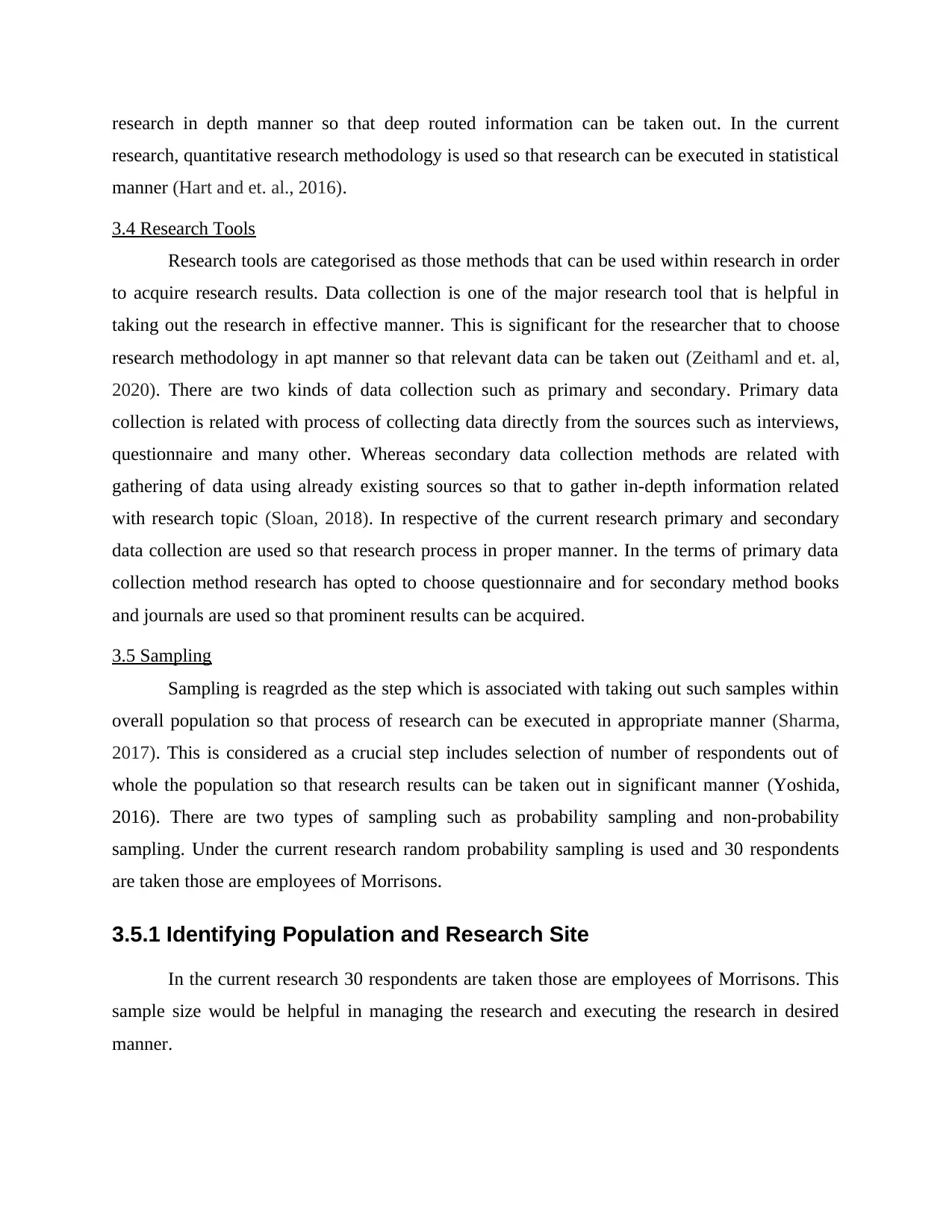
research in depth manner so that deep routed information can be taken out. In the current
research, quantitative research methodology is used so that research can be executed in statistical
manner (Hart and et. al., 2016).
3.4 Research Tools
Research tools are categorised as those methods that can be used within research in order
to acquire research results. Data collection is one of the major research tool that is helpful in
taking out the research in effective manner. This is significant for the researcher that to choose
research methodology in apt manner so that relevant data can be taken out (Zeithaml and et. al,
2020). There are two kinds of data collection such as primary and secondary. Primary data
collection is related with process of collecting data directly from the sources such as interviews,
questionnaire and many other. Whereas secondary data collection methods are related with
gathering of data using already existing sources so that to gather in-depth information related
with research topic (Sloan, 2018). In respective of the current research primary and secondary
data collection are used so that research process in proper manner. In the terms of primary data
collection method research has opted to choose questionnaire and for secondary method books
and journals are used so that prominent results can be acquired.
3.5 Sampling
Sampling is reagrded as the step which is associated with taking out such samples within
overall population so that process of research can be executed in appropriate manner (Sharma,
2017). This is considered as a crucial step includes selection of number of respondents out of
whole the population so that research results can be taken out in significant manner (Yoshida,
2016). There are two types of sampling such as probability sampling and non-probability
sampling. Under the current research random probability sampling is used and 30 respondents
are taken those are employees of Morrisons.
3.5.1 Identifying Population and Research Site
In the current research 30 respondents are taken those are employees of Morrisons. This
sample size would be helpful in managing the research and executing the research in desired
manner.
research, quantitative research methodology is used so that research can be executed in statistical
manner (Hart and et. al., 2016).
3.4 Research Tools
Research tools are categorised as those methods that can be used within research in order
to acquire research results. Data collection is one of the major research tool that is helpful in
taking out the research in effective manner. This is significant for the researcher that to choose
research methodology in apt manner so that relevant data can be taken out (Zeithaml and et. al,
2020). There are two kinds of data collection such as primary and secondary. Primary data
collection is related with process of collecting data directly from the sources such as interviews,
questionnaire and many other. Whereas secondary data collection methods are related with
gathering of data using already existing sources so that to gather in-depth information related
with research topic (Sloan, 2018). In respective of the current research primary and secondary
data collection are used so that research process in proper manner. In the terms of primary data
collection method research has opted to choose questionnaire and for secondary method books
and journals are used so that prominent results can be acquired.
3.5 Sampling
Sampling is reagrded as the step which is associated with taking out such samples within
overall population so that process of research can be executed in appropriate manner (Sharma,
2017). This is considered as a crucial step includes selection of number of respondents out of
whole the population so that research results can be taken out in significant manner (Yoshida,
2016). There are two types of sampling such as probability sampling and non-probability
sampling. Under the current research random probability sampling is used and 30 respondents
are taken those are employees of Morrisons.
3.5.1 Identifying Population and Research Site
In the current research 30 respondents are taken those are employees of Morrisons. This
sample size would be helpful in managing the research and executing the research in desired
manner.
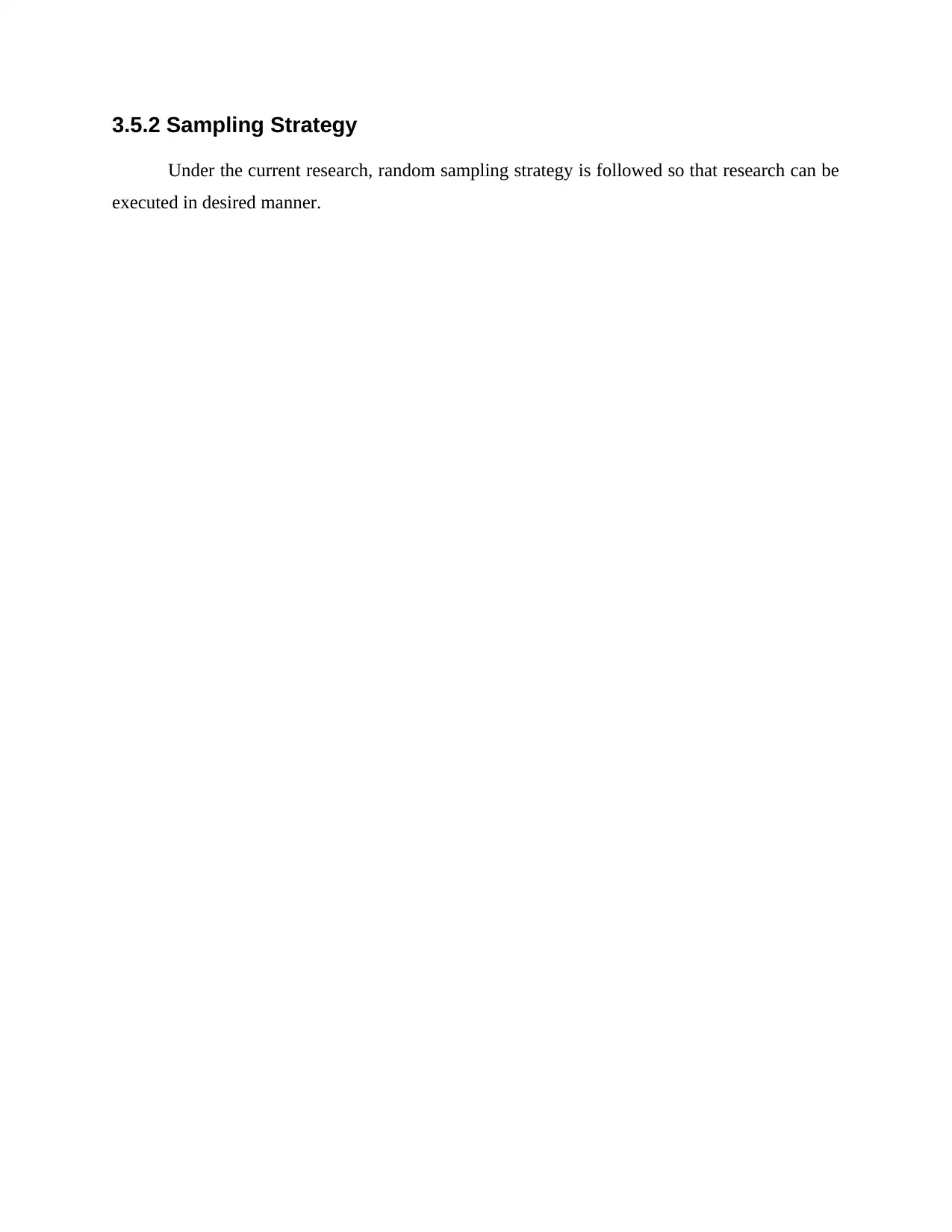
3.5.2 Sampling Strategy
Under the current research, random sampling strategy is followed so that research can be
executed in desired manner.
Under the current research, random sampling strategy is followed so that research can be
executed in desired manner.
⊘ This is a preview!⊘
Do you want full access?
Subscribe today to unlock all pages.

Trusted by 1+ million students worldwide
1 out of 28
Related Documents
Your All-in-One AI-Powered Toolkit for Academic Success.
+13062052269
info@desklib.com
Available 24*7 on WhatsApp / Email
![[object Object]](/_next/static/media/star-bottom.7253800d.svg)
Unlock your academic potential
Copyright © 2020–2025 A2Z Services. All Rights Reserved. Developed and managed by ZUCOL.




